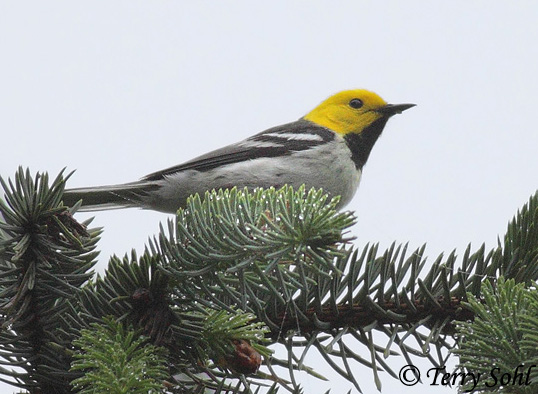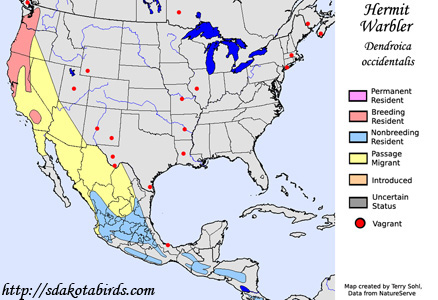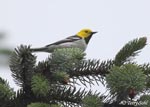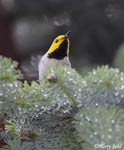| Length: 5 inches | Wingspan: 8 inches | Seasonality: Non-resident in South Dakota |
| ID Keys: Bright yellow head, gray above, white below, 2 prominant wing-bars, black throat on male | ||
 The
Hermit Warbler is a western warbler of wet conifer forests, where it is
typically more easily heard than seen. They typically forage high in
the canopy, and while nests are somewhat closer to the ground, they
typically stay at mid- or higher-levels of the canopy at most times. They
are closely related to the Townsend's
Warbler, and the two species do interbreed and produce hybird offspring
in some locations where their summer range overlaps.
The
Hermit Warbler is a western warbler of wet conifer forests, where it is
typically more easily heard than seen. They typically forage high in
the canopy, and while nests are somewhat closer to the ground, they
typically stay at mid- or higher-levels of the canopy at most times. They
are closely related to the Townsend's
Warbler, and the two species do interbreed and produce hybird offspring
in some locations where their summer range overlaps.
Habitat: During the summer breeding season, found in wet, dense conifer forests, typically either near the coast or in cooler, wet forests at higher elevations. Preferred habitats include forests of Douglas fir, western recedar, and hemlock. During winter, found in a greater variety of forested habitats, including mixed oak and conifer forests.
Diet: Feeds mostly on insects and spiders.
Behavior: Often forages similarly to a Brown Creeper, but "horizontally". Where a Brown Creeper will fly to the base of a tree and move up the trunk in search of food, Hermit Warblers often forage by flying to the trunk of a tree, and then moving horizontally outward along the branch, searching for insects on the branches and foliage. When they get towards the end, they fly back to the trunk and begin on another branch. They will also fly out from a perch to capture flying insects in mid-air.
Nesting: The nest of a Hermit Warbler is a deep cup built of moss, stems of herbaceous vegetation, lichen, conifer needles, and twigs, and lined with softer material such as feathers or plant down. It is placed anywhere from 20 to 120 feet from the ground. The female builds the nest. Both parents likely incubate the eggs and held to raise the young, but given the height of Hermit Warbler nests and the dense forests they inhabit, breeding and nesting details are currently poorly understood.
Song: The song is typically a fast series of buzzy, high-pitched notes, faster towards the end and ending with notes of a different pitch. Song is variable however.
Migration: Summers in the Pacific Northwest from San Francisco Bay to the Canadian border, as well as the mountains of southern California. Winters in Mexico and Central America.
Interactive eBird Map: Click here to access an interactive eBird map of Hermit Warbler sightings
Similar Species: Townsend's Warbler, Black-throated Green Warbler
Conservation Status: Still common within its normal range, and the IUCN lists it as a species of "Least Concern".
Further Information: 1) Cornell's All About Birds - Hermti Warbler
2) Audubon - Hermit Warbler
3) BirdWeb.org - Hermit Warbler
Photo Information: Photo taken on June 29th, 2011 - Ecola State Park, Oregon - Terry Sohl
| Click below for a higher-resolution map |
 |
| South Dakota Status: Non-resident in South Dakota |
Additional Hermit Warbler Photos
Click for a higher-resolution version of these photos


